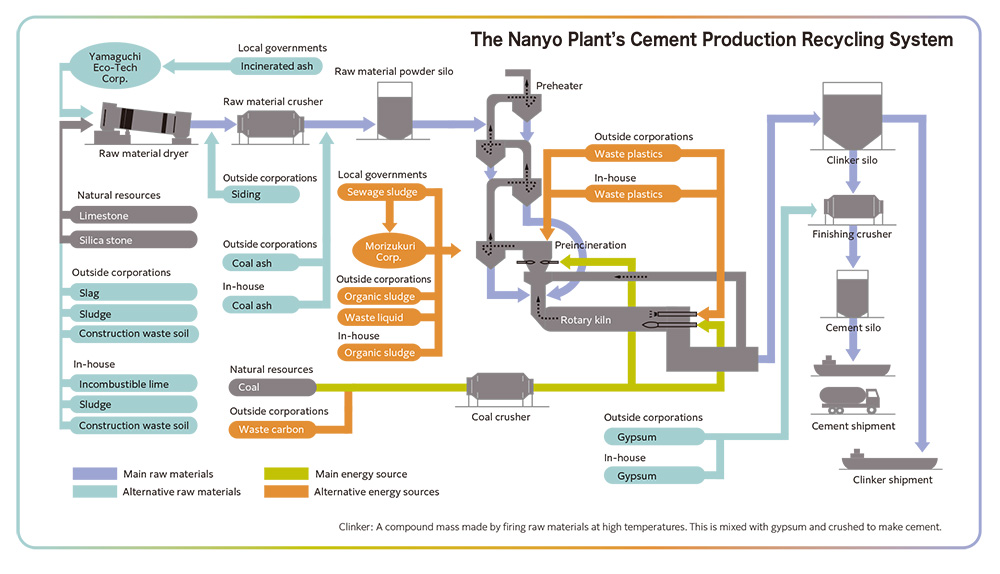Sustainability
Reducing Substances with Environmental Impact and Waste
Reducing Substances with Environmental Impact and Waste
Tokuyama is continually working to reduce its emissions of air and water pollutants and implementing environmental conservation initiatives such as waste recycling.
Reducing Air Pollutants
Amounts of Atmospheric Emissions
In order to reduce atmospheric pollution from sulfur oxides (SOx) and nitrogen oxides (NOx and Soot), Tokuyama equips boilers, cement kilns, and other pollutant-generating facilities with flue gas desulfurizers, denitration equipment, low-NOx burners, and high-performance dust collectors.
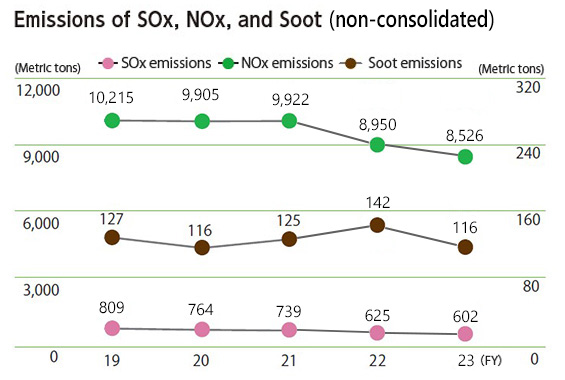
Emissions of Pollutant Release and Transfer Register (PRTR)*Substances
The emissions of the substances listed in the PRTR law in Japan are as follows. Tokuyama is implementing continuous measures and working hard for reducing the emissions of substances which may be harmful to human health and ecosystems.
*The PRTR system collects and publishes data on the sources of designated harmful chemical substances and the amounts of these substances discharged in the environment or transported from production sites as part of waste matter
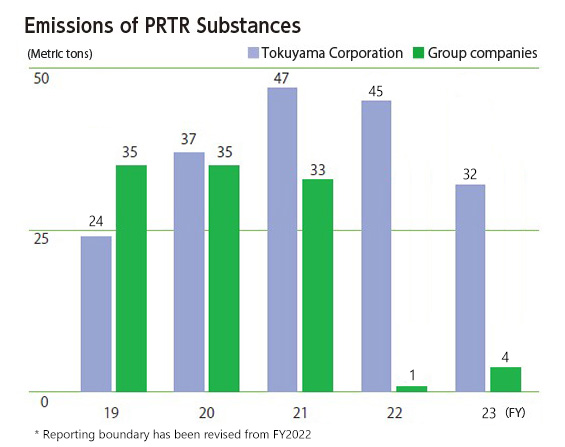
VOC (Volatile Organic Compounds) Emissions
We have established a voluntary reduction plan for volatile organic compounds (VOCs) in accordance with the Air Pollution Control Act in Japan, and are continuously implementing measures to reduce emissions.
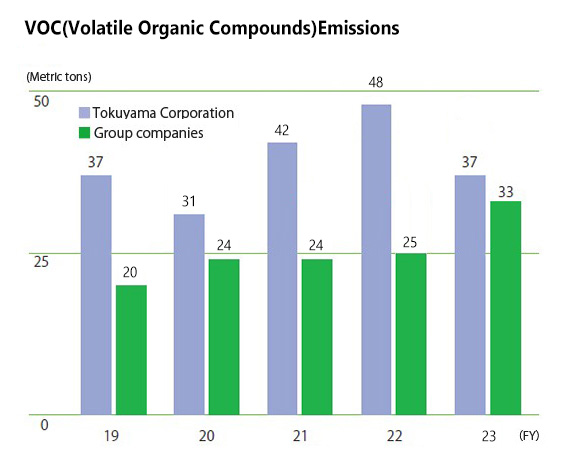
Use of water resources
Tokuyama Factory uses a large amount of water for manufacturing. On the other hand, through the analysis of risks and opportunities, it became clear that climate change and water issues are closely related in our company, so we have set targets and are managing them appropriately.
Management of Water Withdrawal
・We aim to conserve water by not exceeding the amount of tap water used in the previous year.
・For industrial water, which is used for cooling water and process water, we check the amount of water stored in dams every day and set the water saving rate according to the storage rate for management.
・For cooling water, which is used at a rate of 1.5 million m3/day, we are trying to achieve the target water conservation rate by effectively utilizing condensed water of approximately 25,000 m3/day and circulating it with industrial water at a rate of 100,000 m3/day or less.
Water Quality Management
In order to comply with legal regulations and agreed values with local governments, we have established stricter voluntary control values to ensure thorough management by monitoring of contaminants and purification using wastewater treatment facilities. We are reducing emissions of COD*, nitrogen, and phosphorus, which are subject to the regulation of total emission for water quality, through activated sludge treatment facilities and other measures.
* COD: Chemical Oxygen Demand. One of the indicators of water contamination. Oxygen demand is the amount of oxygen consumed when organic matter in water is oxidized.
The table below can be scrolled horizontally
| Water withdrawal(consolidated) | Unit:thousand m3 | ||||
|---|---|---|---|---|---|
| FY2020 | FY2021 | FY2022 | FY2023 | FY2024 | |
| Industrial water (including river water) |
45,167 | 43,585 | 41,617 | 38,640 | 41,766 |
| Ground water | 0.1 | 0.1 | 0.1 | 102 | 11 |
| Sea water | 524,701 | 530,221 | 534,053 | 547,915 | 528,682 |
| Tap water | 481 | 627 | 245 | 308 | 297 |
| Total | 570,349 | 574,433 | 575,915 | 586,966 | 570,756 |
| Water discharge(consolidated) | Unit:thousand m3 | ||||
|---|---|---|---|---|---|
| FY2020 | FY2021 | FY2022 | FY2023 | FY2024 | |
| Sea,River | 568,948 | 572,942 | 575,012 | 585,930 | 569,319 |
| Ground | 0 | 0 | 0 | 0 | 0 |
| Sewage | 862 | 940 | 359 | 522 | 527 |
| Total | 569,809 | 573,881 | 575,371 | 586,451 | 569,846 |
| Recycled water(consolidated) | Unit:thousand m3 | ||||
|---|---|---|---|---|---|
| FY2020 | FY2021 | FY2022 | FY2023 | FY2024 | |
| Recycled water | 559,987 | 553,090 | 564,783 | 589,008 | 543,603 |
| Water pollution(consolidated) | Unit:thousand m3 | ||||
|---|---|---|---|---|---|
| FY2020 | FY2021 | FY2022 | FY2023 | FY2024 | |
| COD | 139 | 184 | 180 | 148 | 140 |
| Nitrogen | 182 | 164 | 167 | 165 | 168 |
| Phosphorus | 2 | 2 | 3 | 3 | 2 |
Reducing Waste and Managing Waste Recycling
The effective utilization rate for waste and the “zero emissions” rate remained high in fiscal 2023, due to efforts to reduce the volume of waste and comprehensive recycling efforts.
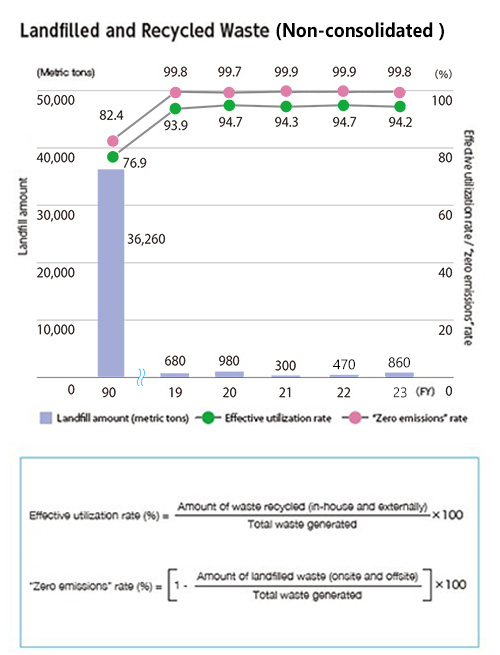
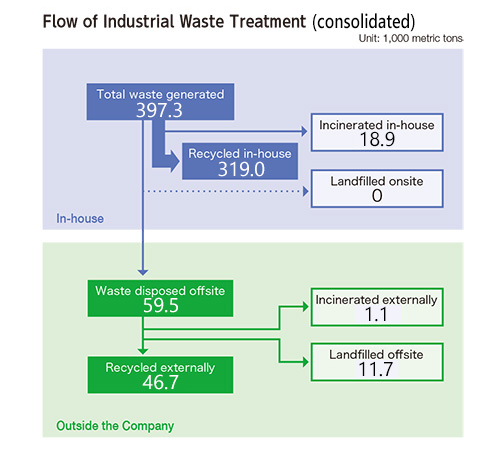
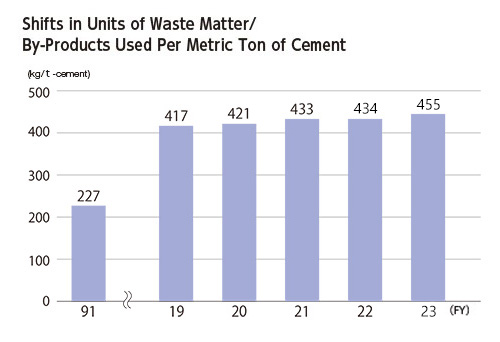
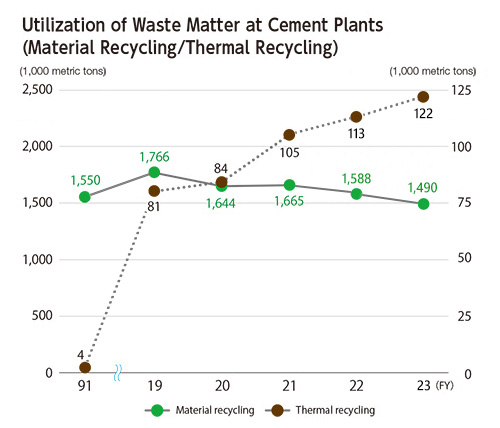
PCB Waste Disposal
The disposal of PCB waste classified as "high concentration" in Japan was completed in FY2023. And we continue to systematically dispose of PCB waste classified as "low concentration" in Japan.
The Nanyo Plant's Cement Production Recycling System
